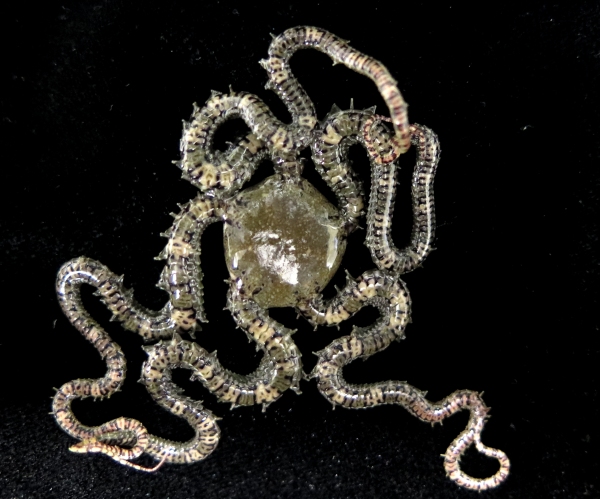The mottled brittle star Ophionereis fasciata, known as weki huna in Māori, lives under rocks in the low intertidal or shallow subtidal right around New Zealand. Though we have some rare records from 300 m deep at its extreme.
Their stripy, spiky arms look a little bit like a centipede sticking out from under boulders and in rock crevices. They feed by filtering tasty morsels from the water column through mucus screens between their armspines.
The jaw of a brittle star is lined by oral papillae, (little square teeth-like blocks) and it has a row of teeth inside the jaw structure that grind up prey - you can just see them inside the centre of the disc in the image below.
Food is transported to the mouth by the tube feet, which poke out from holes next to each of the armspines. This little video clip shows the tube feet in action when flipping over in a dish of seawater.
Ophionereis fasciata is biolumninescent, which means if disturbed blue flashes of light can be seen along the arms of the animal. This only lasts for 20-30 seconds and can only be seen in total darkness (Mallefet et al., 2004), so night divers might be able to glimpse this if they are lucky. It uses these flashes of light to signal that it is un-tasty to potential predators. The study by Mallefet et al. (2004) detected bioluminescence in several other brittlestar species during their study, so it might be a more common feature than we think.
This photo of the armtip of Ophioeneris fasciata is evidence that they may still be pretty tasty to predators though. The armtip is smaller and a different colour than the rest of the arm because it has regrown after being broken off. The armtip could have been nipped off by a fish or broken off when the animal was disturbed.
Brittlestars, and other species of echinoderms have the remarkable ability of autotomy to self-amputate and regrow parts of their body as a defensive reaction to potential predators. Sometimes this method is also used to reproduce asexually, and a small piece of brittlestar can regrow into a whole other animal. This is called fission or fissiparity, and can be seen in many of the ophiuroid families, e.g., in the Ophiactidae family it is seen in Ophiactis savignyi and Ophiactis hirta.
Further information:
- NIWA - Extraordinary Echinoderms - An interactive guide to the sea stars, brittle stars, feather stars, sea eggs, and sea cucumbers (echinoderms) of New Zealand.
- Rod Morris Photography - Ophionereis fasciata and other intertidal and shallow subtidal sea creatures
- New Zealand Geographic - The mottled brittle star, weki huna

